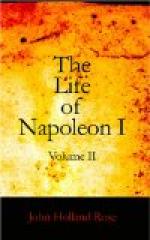Their plan was rash, even for an army which numbered about 80,000 men. The Austrian General Weyrother had convinced the Czar that an energetic advance of his left wing, which rested on the southern spurs of the Pratzenberg, would force back Napoleon’s right, which was ranged between the villages of Kobelnitz and Sokelnitz, and so roll up his long line that stretched beyond Schlapanitz. This move, if successful, would not only win the day, but decide the campaign, by cutting off the French from their supplies coming from the south and driving them into the exhausted lands around Olmuetz. Such was Weyrother’s scheme, which enchanted the Czar and moved the fears of the veteran Kutusoff: it was expounded to the Russian and Austrian generals after midnight on December the 2nd. Strong in the great central hill, the Pratzenberg, and the cover of its village at the foot, the Czar had no fear for his centre: to his right or northern wing he gave still less heed, as it rested firmly on villages and was powerful in cavalry and artillery; but his left wing, comprising fully two-fifths of the allied army, was expected easily to defeat Napoleon’s weak and scattered right, and so decide the day. Kutusoff saw the peril of massing so great a force there and weakening the centre, but sadly held his peace.
Napoleon had already divined their secret. In his order of battle he took his troops into his confidence, telling them that, while the enemy marched to turn his right, they would expose their flank to his blows. To announce this beforehand was strangely bold, and it has been thought that he had the plan from some traitor on the enemy’s staff. No proof of this has been given; and such an explanation seems superfluous to those who have observed Napoleon’s uncanny power of fathoming his adversary’s designs. The idea of withdrawing one wing in order to tempt the foe unduly to prolong his line on that side, and then to crush it at the centre, or sever it from the centre, is common both to Castiglione and Austerlitz. It is true, the peculiarities of the ground, the ardour of the Russian attack, and the vastness of the operations lent to the present conflict a splendour and a horror which Castiglione lacked. But the tactics which won both battles were fundamentally the same.
He had studied the ground in front of Austerlitz; and the priceless gift of strategic imagination revealed to him what a rash and showy leader would be certain to do on that ground;[42] he tempted him to it, and the announcement of the enemy’s plan to the French soldiery supplied the touch of good comradeship which insured their utmost devotion on the morrow. At midnight, as he returned from visiting the outposts, the soldiers greeted him with a weird illumination: by a common impulse they tore down the straw from their rude shelters and held aloft the burning wisps on long poles, dancing the while in honour of the short gray-coated figure, and shouting, “It is




